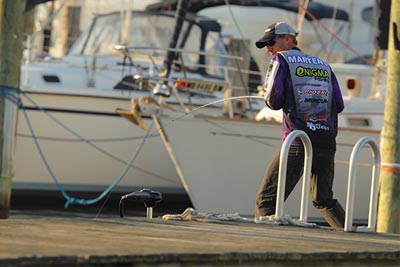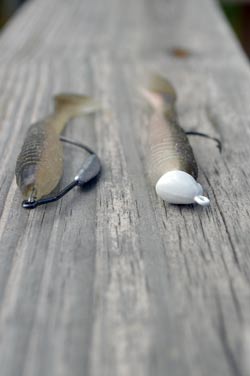
Tucked deep within Florida’s Harris Chain of Lakes, 2017 Bass Fishing Hall of Fame inductee Shaw Grigsby uncovered a hidden gem during a recent Bassmaster Elite Series tournament. It was springtime in the Sunshine State, and bass — big ones — had swarmed a dock-lined residential canal.
The bass were there to bask in the canal’s protected water. It was well insulated from biting northern winds and influxes of colder water from the main lake. Its hard bottom was perfect for fanning out spawning beds. And, if conditions got terrible, they could make a quick escape to nearby deep water.
Grigsby, who amicably shared the spot with the second-place finisher, led three of the event’s four days, amassing 75 pounds and 4 ounces which was enough for his ninth B.A.S.S. win. While the pattern gave him his most recent win, fishing canals in the spring is nothing new to the Gainesville, Fla.-based angler who has banked more than $2.1 million from fishing nearly 350 B.A.S.S. tournaments.
“Canals aren’t the only place with prime spawning conditions,” Grigsby said. Marinas offer the same benefits, which are more plentiful on lakes, reservoirs, and rivers nationwide. That’s not lost on him when he’s searching for spawners. “They’re my first place [to fish in spring],” he said.
What they offer
Plenty of pieces need to be in place before most bass will spawn. The water needs to be warm — from the mid-50s to the mid-60s — and the moon full. They also want security from predators, such as panfish, which eat their eggs and eventually their fry. So, they make beds next to objects such as logs, weed clumps, dock posts, or seawalls.
Grigsby said marinas meet all those needs. Located in the back of bays and canals or surrounded by docks and sometimes break walls, their waters don’t easily mix with the main lake. “Out on the main lake, you have wind,” he said. “The best thing is a marina, canal, basin — anything protected can heat up fast. That’s especially attractive to early spawners”, he said.
Marinas offer something for bass during each stage of the spawn. Grigsby said prespawn bass suspend under moored boats and docks, regardless of how much water is under them. “It could be 30 feet of water,” he said. “It doesn’t matter.” The clearer the water, the deeper he expects them to be under that overhead cover. Postspawn bass will use those spots as they travel to their summer spots after spawning.
Beyond stable warm water and plentiful cover, there is one more thing that spawning bass want — a patch of hard bottom that’s shallow enough for sunlight to reach. And it doesn’t have to be significant.
Grigsby heads to the back of the marina first. Where water meets land is the most likely spot to find a spawning bank. He’ll even look behind docks, especially floaters secured with cables and accessed by walkways. “Sometimes I have to pull in the [boat] slips and look over the other side,” he said. “Any way I can get to the shallower side.”

Grigsby has seen bass spawn along seawalls, primarily where sediment collects at an inside corner. “You can see that’s where they will spawn,” he said. Sediment also collects where runoff, such as a small stream or a storm drain from the parking lot, enters the marina. As soon as it does, its water slows, dropping enough sediment to form a small sandbar.
But marina bass don’t always define shallow water by the distance between the surface and bottom. Grigsby said they’ll spawn on the horizontal cross members that connect docks. They also use the top of boat lift floats if they stay submerged. “Any small flat surface, you’ll see it shined up,” he said.
Tackle to use
Grigsby said marina bass can be caught everywhere on the same lures used for spawning. When he won the Elite Series tournament on the Harris Chain, he fished an array of time-tested soft-plastic lures in several colors, including creature baits and ringworms. He does throw a relatively new one at marina bass that have yet to bed. And that’s a small swimbait.
Grigsby rigs his, a Strike King Rage Swimmer, on a 4/0 Eagle Claw Trokar TK 140 hook. Its wide gap collects the bulky soft-plastic lure when you set the hook, leaving plenty of point to stick in a bass’s mouth. The hook sports a spring-like keeper on its line tie. So, instead of running the hook through the lure, like with traditional Texas rigging, you twist the lure onto the keeper, which makes it last longer. He mainly fishes it weightless, adding a small bullet weight if he wants it to go deeper. A little extra weight also can help improve casting accuracy and distance.
Grigsby pitches the swimbait alongside moored boats and floating docks. Being Texas rigged, it’s less likely to snag than a traditional open-hook rig, though he does use the latter when cover is sparse. Once it’s in the water, let it sink, so your retrieve brings it slightly below dock floats and boats. That ensures the bass see it.
Take careful aim
Grigsby recalls a tournament when he and fellow Elite Series angler Edwin Evers were fishing the same marina. He watched Evers make a long cast between the pontoons of an enormous houseboat. He said Evers hung his lure there and broke it off. “While snags and lost lures are part of fishing in marinas, you can’t let it deter you from putting your lure where bass live,” he said.

If you cast over a cable or rope, for example, let your lure stop swinging, reel it to the cable and flick your rod tip. That’s usually enough to get it on the right side, especially if it’s Texas rigged or sports a single hook. But you will spend more time fishing if you avoid snags in the first place. Casting accuracy is essential, whether fishing for prespawn or spawning bass.
And not only do you have to slide your bait between objects, but you may not have much room to fish it once it’s on target. That’s especially true when you find a bass bedding on a cross beam that is a few inches wide in most cases. “You have to be good,” Grigsby said.
One way to improve casting accuracy is by using a spinning rod, which has fallen out of favor as a sight-fishing tool in recent years. There was a time that their light line and finesse offerings, such as tubes, ruled the technique. Even Grigsby was known to whip one around. Today, most anglers grab a heavy action casting rod strung with braided line that’s tied to a bulky bait. To them, sight fishing torment a bass into striking rather than encouraging it.
While heavier tackle will get you bites from spawning bass, spinning rods make it easier to skip lures under docks and mooring lines or to the back of occupied boat slips. You can concentrate on your casts without the spool control worries that come with casting reels. The key is timing your lure’s first skip, not how much force you put into your rod. Gently skipped lures travel truer and farther.
A key component of longer lure skips is braided line. It’s supple, flowing effortlessly from the spool, and abrasion-resistant. Braided line eliminates fears of breaking off a bass that wraps your line around a dock post or saws it across a propeller. And, if you’re concerned that it’s too visible for timid clear-water bass, add a short fluorocarbon or monofilament leader ahead of your lure.
Pack some courtesy
You can catch bass in marinas year-round. Aaron Martens proved that in 2015 when he caught 70 pounds and 2 ounces of summertime bass from a marina’s docks to win a Bassmaster Elite Series tournament on Maryland’s Chesapeake Bay. Whether you fish them for spawners, like Grigsby, or during the summer as Martens did, you should always bring some courtesy.
Most of the time, fishing inside marinas is an enjoyable experience. But every angler who has done so can recall a time when things got choppy with another marina user, usually over whether or not fishing was allowed. Thankfully it almost always escalates no further than words. And most of those heated interactions can be squelched with common courtesy.
First, be sure you can fish in that marina, whether that’s the permission set out in law or by the owner. Be mindful of property, whether it belongs to the marina or one of its customers. They like to keep their boats looking nice, just like you, so avoid bumping into or banging lures off them. Make every effort to retrieve hung lures. “I don’t like leaving anything in a rope,” Grigsby said.
Fish quietly, especially early in the day, because some owners sleep on their boats. And if someone asks you what you are fishing for or how you are catching them, take time to explain. Sometimes that investment can keep out the welcome mat.
BassResource may receive a portion of revenues if you make a purchase using a link above.




